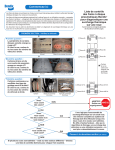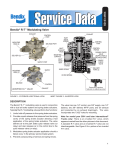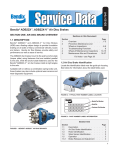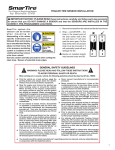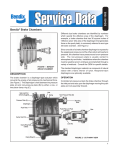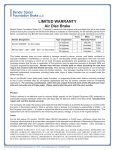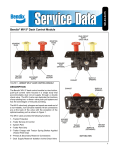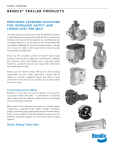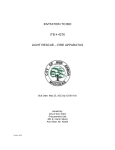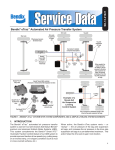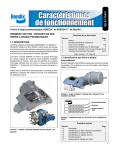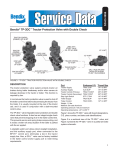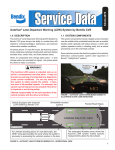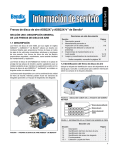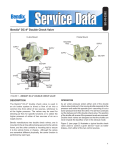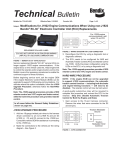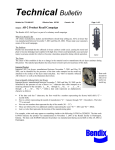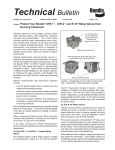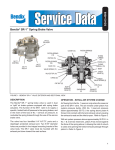Download BENDIX BW7514 User's Manual
Transcript
Start Here All foundation brakes are designed to convert kinetic energy (energy of motion) into heat and work (to stop the vehicle). Air disc brakes work the same way and in everyday operation — compared to drum brakes — will produce higher braking temperatures and cool off faster. Also, air disc brakes will often have differences in temperatures at wheel ends on the same axle. The actual temperatures reached will depend on the vehicle configuration, vocation and brake usage. This document is intended to help technicians identify instances where an individual wheel end has evidence of thermal overload, and check for potential causes. Bendix Air Disc Brake Checklist for Identifying Single Wheel End Thermal Overload ® Follow all General Safety Guidelines (see final page.) SECTION ONE: Inspect the Vehicle c L. Steer Question One: Do any of the rotors have bright orange or red color edges? Check the box(es) on the vehicle diagram to the right for any found. c L. Drive Normal Steer Axle Drive Axle Question Three: Are any tappets and/or guide pin boots heat damaged? Check the box(es) on the vehicle diagram to the right for any found. c R. Drive Evidence of thermal overload c L. Add’l. Question Two: Are any of the calipers coated with a bright orange or red colored dust? Check the box(es) on the vehicle diagram to the right for any found. c R. Steer c R. Add’l. Additional Axle Normal Check box(es) where Thermal Overload is suspected. Evidence of thermal overload c L. Trlr. Front c L. Trlr. Rear Typical Evidence of thermal overload Are any boxes checked? Trailer Front Axle Trailer Rear Axle c R. Trlr. Front c R. Trlr. Rear Evidence of thermal overload STOP! Exit this flowchart. NO YES Are both boxes on a single axle checked? YES NO Only one box has a check mark? YES This is not a single wheel end Thermal Overload event. When both ends of an axle are affected, a thorough brake system diagnosis is needed, as other factors — such as brake balance, overloaded vehicles, or extreme use — are more likely the source. Go to Section Two (over) NO In cases where more than one wheel end is affected — but on different axles — complete a separate checklist for each brake being examined. SECTION TWO: Investigate Other Potential External Causes • Follow all Safe Maintenance Practices (see final page.) Inspect the brake pads. (New pads have 21 mm of brake pad, plus a 9 mm backing plate.) Is there 2 mm, or less, of brake pad friction material?* YES *2 mm of friction material, plus a 9 mm backing plate, for a total of 11 mm. NO Inspect the caliper Replace the pads (axle set recommended) after performing all Section Two inspections. (Not a Thermal Overload warranty condition.) Push/pull by hand to check the caliper movement [at least 0.75 Inch (20 mm) with the pads removed] Does the brake caliper have restricted movement in the inboard/outboard direction? YES Complete this step on level ground, with the wheels chocked and the parking brake temporarily released! Service the guide pins. Perform all Section Two inspections. (Not a Thermal Overload warranty condition.) NO Inspect the air hoses (“jounce lines”). • Is air trapped in the hose?** • Do the hose(s) pull or push on the caliper? (It is important that the hoses permit the lateral motion of the caliper, the vertical motion of the suspension, and — for steering axles — the full turn of the wheels.) • Are there any kinks, restrictions? **Take full safety precautions during the inspection for trapped air, to avoid the air hose whipping if air pressure is found to be trapped. Conditions that might cause trapped air include kinked lines, or when an ABS modulator is malfunctioning and not exhausting service air. • Are the hoses in good condition? Are any of these conditions found? Service as needed. Perform all Section Two inspections. (Not a Thermal Overload warranty condition.) YES NO Go to the next page . . . 2 SECTION TWO Continued Inspect the actuator. On level ground, with the wheels chocked, cage the spring brake actuator (if equipped) per the manufacturer’s guidelines, remove and inspect the actuator. • Is there visible damage? • In the installed position, was the lowest drain plug sealed? • Is the seal in poor condition/damaged? • Does the push-rod extend further than 15 mm from the mounting face? Are any of these conditions found? YES Service the actuator. (Not a Thermal Overload warranty condition.) NO With the actuator removed, inspect the internal caliper surfaces through the actuator push rod opening. Are any of these conditions found? • Is there visible damage, rust, water? • With the pads removed, use a screw driver to depress the lever. Does the lever have a restricted range of motion? (The lever must touch the caliper body when fully retracted.) YES Replace the caliper. Inspect the rotor. (Not a Thermal Overload warranty condition.) NO No Section Two external causes found? Replace the caliper. Where applicable, process a thermal overload warranty claim. Actions When Replacing a Caliper Replacement: c Replace the caliper on the affected wheel end and all the pads at both ends of the axle. c Inspect the rotor according to the guidelines in Service Data sheet SD‑23‑7541. If the brake assembly is still under warranty coverage: c File a claim. Clearly state the claim is for a single axle thermally overloaded brake. The claim must include photographs of the rotor from both ends of the affected axle. c Return the caliper from the affected wheel end, and label the caliper with the claim number. c Return the pads from both sides of the affected axle (LH and RH set of pads). Please clearly label the parts with the wheel position and claim number. c Please include this completed checklist, the photographs of the rotors, and a copy of the warranty claim with the returned parts. VIN #: __________________________________ Claim #: ________________________ Vehicle Make: ____________________________ Vehicle Model: ___________________ Mileage: ____________________ Where other external causes were found, perform service and exit this flowchart. Bendix® ADB22X® Air Disc Brake Replacement Part Numbers Caliper/Carrier Axial Bolt 12 degree Right Fixed Pin K081142 Left Fixed Pin K081143 Vertical Bolt 12 degree Right Fixed Pin K081256 Left Fixed Pin K081257 Left Fixed Pin Right Fixed Pin Please note that replacement caliper/carrier bolts (available from the vehicle manufacturer) are recommended. Caliper Only 12 degree Right Fixed Pin K081258 Left Fixed Pin K081259 Bendix TechTeam Help Line: 1‑800‑AIR‑BRAKE, <Part Number> <Serial Number> Caliper Part Number: _________________ Caliper Serial Number: _________________ (Air Disc Brake Label) 3 (1‑800‑247‑2725), option 2-1. Mon. - Fri., 8 a.m. - 6 p.m. Reference Document: Service Data: SD‑23‑7541 Bendix® ADB 22X™, ADB 22X‑V™ Air Disc Brakes. Go to the document library at www.bendix.com for free downloads of Service Data Sheets and warranty policies. GENERAL SAFETY GUIDELINES WARNING: Not all wheels and valve stems are compatible with Bendix Air Disc Brakes. Use only wheels and valve stems approved by the vehicle manufacturer to avoid the risk of valve stem shear and other compatibility issues. WARNING! PLEASE READ AND FOLLOW THESE INSTRUCTIONS TO AVOID PERSONAL INJURY OR DEATH: When working on or around a vehicle, the following guidelines should be observed AT ALL TIMES: WARNING: AVOID CREATING DUST. POSSIBLE CANCER AND LUNG DISEASE HAZARD. ▲ Park the vehicle on a level surface, apply the parking brakes and always block the wheels. Always wear personal protection equipment. ▲ Stop the engine and remove the ignition key when working under or around the vehicle. When working in the engine compartment, the engine should be shut off and the ignition key should be removed. Where circumstances require that the engine be in operation, EXTREME CAUTION should be used to prevent personal injury resulting from contact with moving, rotating, leaking, heated or electrically-charged components. ▲ Do not attempt to install, remove, disassemble or assemble a component until you have read, and thoroughly understand, the recommended procedures. Use only the proper tools and observe all precautions pertaining to use of those tools. ▲ If the work is being performed on the vehicle’s air brake system, or any auxiliary pressurized air systems, make certain to drain the air pressure from all reservoirs before beginning ANY work on the vehicle. If the vehicle is equipped with a Bendix® AD-IS® air dryer system, a Bendix® DRM™ dryer reservoir module, or a Bendix® AD-9si™ air dryer, be sure to drain the purge reservoir. ▲ Following the vehicle manufacturer’s recommended procedures, deactivate the electrical system in a manner that safely removes all electrical power from the vehicle. ▲ Never exceed manufacturer’s recommended pressures. ▲ Never connect or disconnect a hose or line containing pressure; it may whip. Never remove a component or plug unless you are certain all system pressure has been depleted. ▲ Use only genuine Bendix® brand replacement parts, components and kits. Replacement hardware, tubing, hose, fittings, etc. must be of equivalent size, type and strength as original equipment and be designed specifically for such applications and systems. ▲ Components with stripped threads or damaged parts should be replaced rather than repaired. Do not attempt repairs requiring machining or welding unless specifically stated and approved by the vehicle and component manufacturer. ▲ Prior to returning the vehicle to service, make certain all components and systems are restored to their proper operating condition. ▲ For vehicles with Automatic Traction Control (ATC), the ATC function must be disabled (ATC indicator lamp should be ON) prior to performing any vehicle maintenance where one or more wheels on a drive axle are lifted off the ground and moving. ▲ The power MUST be temporarily disconnected from the radar sensor whenever any tests USING A DYNAMOMETER are conducted on a Bendix® Wingman® Advanced™-equipped vehicle. ▲ You should consult the vehicle manufacturer's operating and service manuals, and any related literature, in conjunction with the Guidelines above. While Bendix Spicer Foundation Brake LLC does not offer asbestos brake linings, the long-term affects of some nonasbestos fibers have not been determined. Current OSHA Regulations cover exposure levels to some components of non-asbestos linings, but not all. The following precautions must be used when handling these materials. • Avoid creating dust. Compressed air or dry brushing must never be used for cleaning brake assemblies or the work area. • Bendix recommends that workers doing brake work must take steps to minimize exposure to airborne brake lining particles. Proper procedures to reduce exposure include working in a well-ventilated area, segregation of areas where brake work is done, use of local filtered ventilation systems or use of enclosed cells with filtered vacuums. Respirators approved by the Mine Safety and Health Administration (MSHA) or National Institute for Occupational Safety and Health (NIOSH) should be worn at all times during brake servicing. • Workers must wash before eating, drinking or smoking; shower after working, and should not wear work clothes home. Work clothes should be vacuumed and laundered separately without shaking. • OSHA Regulations regarding testing, disposal of waste and methods of reducing exposure for asbestos are set forth in 29 Code of Federal Regulations §1910.001. These Regulations provide valuable information which can be utilized to reduce exposure to airborne particles. • Material Safety Data Sheets on this product, as required by OSHA, are available from Bendix. Call 1‑800‑247‑2725 and speak to the Tech Team or e‑mail [email protected] BW7514 © 2013 Bendix Commercial Vehicle Systems LLC, a member of the Knorr-Bremse Group. 12/13. All Rights Reserved. Printed in USA. 4




